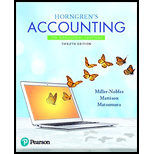
Concept explainers
Comparing amounts for cost of goods sold, ending inventory, and gross profit—FIFO and LIFO
Learning Objective 2, 3 2. Ending March. Inv. $73
Assume that Toys Galore store bought and sold a line of dolls during December as follows:
____________________________________________________________
Dec. 1 Beginning merchandise inventory 13 units @ $ 9 each
8 Sale 8units@$22each
14 Purchase 16 units @ $14 each
21 Sale 14 units @$ 22 each
_____________________________________________________________
Requirements
1. Compute the cost of goods sold, cost of ending merchandise inventory, and gross proM using the FIFO inventory costing method.
2. Compute the cost of goods sold, cost of ending merchandise inventory, and gross profit using the LIFO inventory costing method.
3. Which method results in a higher cost of goods sold?
4. Which method results in a higher cost of ending merchandise inventory?
5. Which method results in a higher gross profit?
Want to see the full answer?
Check out a sample textbook solution
Chapter 6 Solutions
Horngren's Accounting (12th Edition)
- Century 21 Accounting Multicolumn JournalAccountingISBN:9781337679503Author:GilbertsonPublisher:Cengage
 Cornerstones of Financial AccountingAccountingISBN:9781337690881Author:Jay Rich, Jeff JonesPublisher:Cengage Learning
Cornerstones of Financial AccountingAccountingISBN:9781337690881Author:Jay Rich, Jeff JonesPublisher:Cengage Learning


